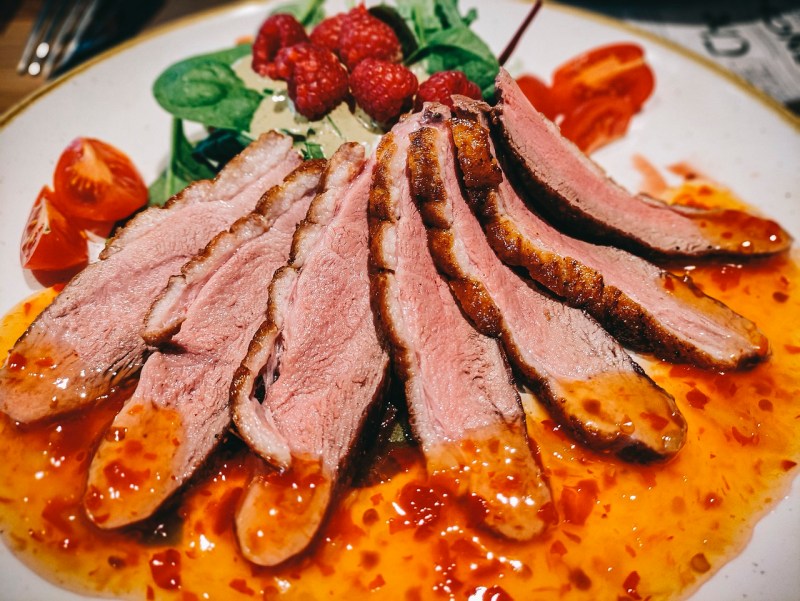Have you ever seen someone grill a flank steak and they nailed the marinade, timed the cooking just right, and even let it rest like the patient adult we all strive to be when it’s time to dig in? I have, and I thought it was a masterclass on how to get a juicy steak out of a fairly lean cut, but that brings me to where things went wrong.
When they sliced it, they cut it the long way, with the grain, and served it up. Everyone chewed. And chewed. And chewed some more. A perfectly cooked steak had the texture of a gym towel. That was the day I learned the hard truth; how you slice your steak matters. Big time. So, what does it mean to cut with or against the grain, and what does that look like if you’rer trying to achieve the most tender steak possible? Let’s get into it.
What does ‘cutting against the grain’ mean?

For starters, and maybe this goes without saying, but, “the grain” has nothing to do with bread or rice. In meat, the grain refers to the direction of the muscle fibers that run through the cut. You can often see them as little lines running in one consistent direction across the meat. When you cut steak, with the grain means you’re slicing in the same direction as the fibers. That will undoubtedly give you long, chewy strands. Against the grain means you’re slicing perpendicular to those fibers, breaking them into shorter pieces. This makes every bite easier to chew and more enjoyable.
Why it matters: The science of tenderness
No matter how well you cook a steak, slicing it wrong can ruin the experience. Cutting against the grain makes steak more tender because:
- It shortens the muscle fibers in each bite
- It reduces chewiness
- It helps the meat “fall apart” more easily in your mouth
Cutting with the grain:
- Leaves long muscle strands intact
- Makes the meat feel stringy and tough
- Turns even a medium-rare beauty into a jaw workout
So if you’ve ever thought, “This cut is tough,” it might not be the steak — it might be your slicing.
How to find the grain in any cut

Here’s where a lot of folks get tripped up; not every steak makes the grain obvious. Here are some tips for spotting the grain:
- Look before you cook: It’s easier to see the grain in raw meat
- Hold it up to the light: Fibers reflect differently than fat
- Feel it: Run your fingers along the surface and note the direction of resistance
- Use a flashlight if needed: No shame in bringing CSI energy to your steak prep!
Grain clues by cut:
- Flank/skirt steak: Grain is bold and linear — easy to see
- Ribeye/sirloin: More marbled, so grain might be subtle
- Brisket: Changes direction mid-cut — be ready to adjust as you go
- When in doubt, cut a tiny slice, check the texture, and adjust.
How to slice steak the right way

Even if you’re not a knife wizard, this method is totally doable.
Method
- Rest your steak: Let it sit for 5–10 minutes after cooking. This keeps juices where they belong.
- Find the grain: Use the tricks above. Identify the direction the fibers run.
- Position the steak: Rotate it on your board so your knife cuts perpendicular to the grain.
- Use a sharp knife: Dull knives mash meat and make uneven slices.
- Slice thinly: Especially with tougher cuts like flank or skirt.
Optional step: Tilt the knife slightly (about 45 degrees) as you slice, as this creates wider, more elegant pieces and helps maximize tenderness.
Want to see the whole “cut against the grain” thing in action? Chef Annabel Langbein breaks it down with a no-fuss demo that shows exactly how to spot the grain and slice like a pro. It’s one thing to read it, but watching it makes it click.
Common cuts where slicing against the grain is crucial

Some steaks are more forgiving than others. Here’s where it really counts:
- Flank steak: One of the best steak cuts to buy, known for flavor, but brutal if sliced wrong
- Skirt steak: Same story—thin, fibrous, needs correct slicing
- Brisket: The grain actually shifts halfway through, so you’ll need to adjust accordingly
- Tri-tip: Beautifully marbled, but don’t get lazy when slicing
- Flat iron steak: Tender, but still benefits from grain-aware slicing
When it comes to high-fat cuts like ribeye or tender cuts like filet, the effect is subtler but still worth considering for top-tier results.
Can you fix it if you cut it wrong?

Short answer? Not really. But you can soften the blow.
If you sliced with the grain:
- Chop it into smaller pieces for stir-fry or tacos
- Toss it with a sauce or dressing to add moisture
- Call it “rustic” and pretend that was your plan all along
- A well-made chimichurri or horseradish sauce can help disguise any slicing sins. And hey, chin-up — your next steak will be better!
If you’re working with raw steak for stir-fry or marinating, you still want to cut against the grain before cooking. Just pop the steak in the freezer for 10–15 minutes first—it firms up and makes slicing easier. For cooked steak, the same rules apply. Let it rest, find the grain, and slice with confidence.
Respect the grain, enjoy the steak

Slicing steak might seem like the final afterthought, but it’s actually one of the most crucial steps. Even if you splurged on the best cut and cooked it like a pro, cutting it the wrong way can turn your masterpiece into a disappointment. Let’s recap the slicing gospel; always cut against the grain, use a sharp knife and slice thinly, adjust your angle if the grain shifts mid-cut, and don’t panic, you got this.




